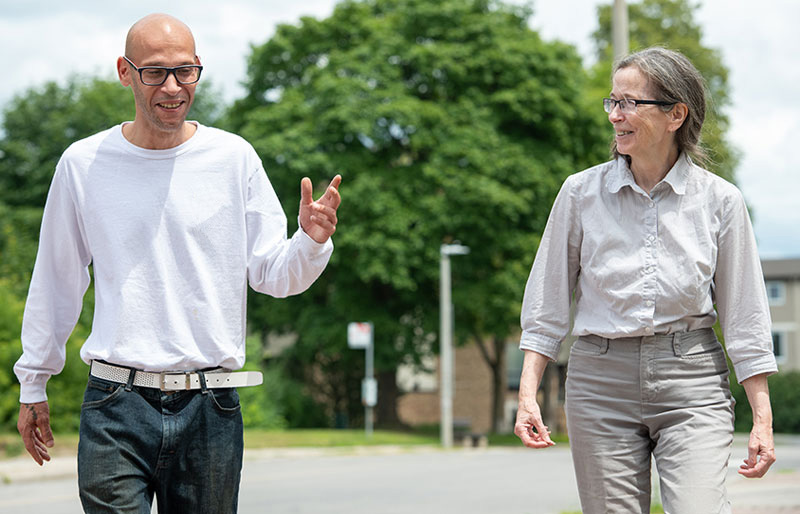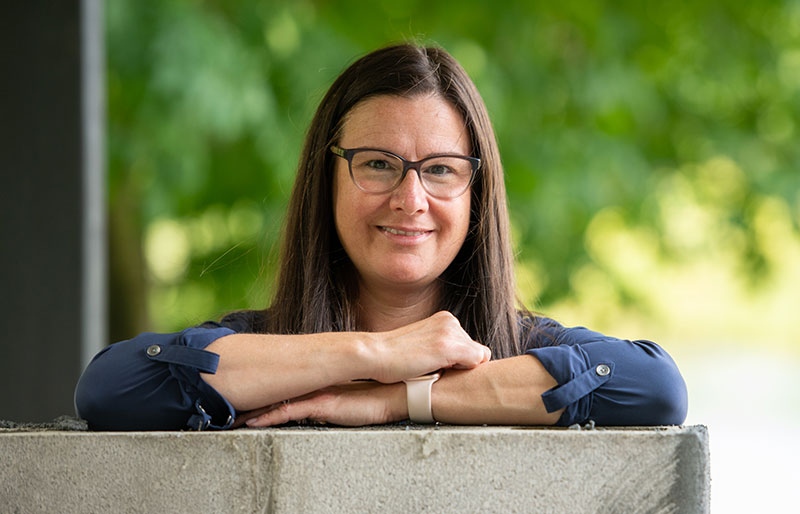Ex-prisoner helps forge new path for others at risk of homelessness
November 5, 2021
AT A GLANCE
- Up to 30% of individuals incarcerated in Canada have no home to go to upon their release
- Limited shelter beds and few resources increase the risk of homelessness for newly-released ex-prisoners
- A team of advocates, experts, and an ex-prisoner with lived experience, is working to change the trajectory for others at risk of homelessness

“For the first 2 or 3 months I was living out of a motel, thanks to some money I had saved up while in prison,” says ex-prisoner, Lawrence Da Silva. “At other times, I was homeless.”
Lawrence’s story is far from unique. More than 100 prisoners are released from federal institutions in Canada every day. Often, they have little or no support to help them transition back into society. Finding shelter is usually their number one priority — and their biggest challenge.
“Between 10 and 30% of federal prisoners are released with nowhere to stay that night,” says Lise Clément, a senior consultant with the Lansdowne Consulting Group. “They have served long sentences and frequently have no identification, no money and no bank account. Even booking a motel room can be difficult. Too often their only options are shelters or the street.”
To help change this narrative, Lansdowne is facilitating a Solutions Lab. From Prison to Homelessness: Ending a Perilous Trajectory is exploring options for housing Canadians who leave the prison system. It is investigating practical ways to improve access to housing for ex-prisoners, and ways to increase housing supply.
The Lab’s project team includes:
- The John Howard Society of Canada (including representatives of the Alberta, Kingston, Edmonton and Toronto chapters)
- National Associations Active in Criminal Justice
- Public Safety Canada, Correctional Service of Canada and Employment
- Social Development Canada.
Lawrence represents former prisoners with lived experienced of homelessness.
Finding a suitable living environment critical for newly released prisoners
“We know that the first 60 days after release are the riskiest in terms of the potential for ex-prisoners to reoffend, especially when they are homeless,” says Julie Langan, executive director of the John Howard Society of Kingston and Area. The eastern Ontario city is home to 6 federal institutions and has a relatively high population of ex-prisoners compared with many other communities.
A 2010 survey (PDF) of prisoners within days of their release from Toronto-area jails revealed:
- 16.4% of prisoners who were housed before being incarcerated anticipated being homeless upon discharge
- 85.5% of those who were homeless before being incarcerated anticipated being homeless again upon discharge
“It often comes down to shelter beds,” she adds. “Just accessing the shelter system is often difficult for prisoners. Shelters are not a clean living environment. There is often drug and alcohol use, which violates parole conditions and is not a good setting for any ex-prisoner.”
Broad-based support to break the cycle
It’s a problem that Catherine Latimer, executive director of the John Howard Society of Canada, is all too familiar with. “For so many former prisoners, the cards are stacked against them even before they’re released,” says Catherine.
She hopes the Lab will find ways to stack the cards in their favour and increase their chances of a successful reintegration to society.
Launched in October 2020, the Lab quickly grew to include more than 40 stakeholders. It has engaged municipal governments, local non-profits, housing providers, a Métis housing provider in Edmonton, Habitat for Humanity Canada, philanthropists and private builders.
For so many former prisoners, the cards are stacked against them even before they’re released.
The barriers are systemic and can be overwhelming for ex-prisoners. Discrimination and marginalization are near the top of the list. Many landlords ‘Google’ prospective tenants and won’t consider anyone who has a criminal record. Similarly, many community housing projects have ‘crime-free’ building policies and don’t accept tenants who have criminal records. A lack of identification and employment add to the obstacles facing ex-prisoners.

“ID is a big thing out there,” says Lawrence, an ex-prisoner with lived experience of homelessness who is acting as facilitator and expert advisor for the project. “I ran into real problems when applying for a health card and welfare. When I was released, I had a birth certificate but nothing else.”
Lawrence’s story
Lawrence’s story is a common one. Released after serving 19 years in prison, he tried to check into a motel, but his lack of ID caused problems. Fortunately, a call to the John Howard Society helped resolve the issue.
“After being released I chose to relocate in Kingston,” explains Lawrence. “I wanted to stay away from old friends and associates in Toronto who were part of my life before I entered prison. For the first 2 or 3 months I was living out of a motel, thanks to some money I had saved up while in prison. At other times, I was homeless because I couldn’t go back to my previous environment. I really felt that would have led me back to prison. After several months I was finally able to get situated in a small apartment in an unsafe neighbourhood.”
Weeks later, he was robbed of his life savings during a break-in at his apartment.
“That was devastating,” he recalls. “But I had to lick the wounds and keep going. I felt I had to get out of Kingston, or I was going to go after someone for stealing the money I had been saving to try to get ahead. There was also a lot of drug use and stuff I wanted to get away from where I was living.”

Lawrence notes that he has lived at 12 different addresses since his release 4 years ago. He has had to move often to be close to the few work opportunities that have been available to him.
“It’s been a lot more stable the past couple of years. Right now, I am living in Ottawa with an old friend and working as a property manager. Because I now have income, I am a lot more secure. But I will only feel really secure when I have a home or apartment in my own name.”
Lawrence suffers from attention deficit disorder and severe PTSD due to experiences both before and after he was imprisoned. These include life-threatening assaults and spending 2,580 days in solitary confinement.
“When I got out, I had a lot of anxiety. I was only given 2 weeks supply of medication. I had to get an emergency doctor to give me a prescription, which was not ideal for my situation. I have a service dog now but I’m still on a waiting list for a doctor.”
Without secure housing, there is constant anxiety and tension. You just don’t know what lies ahead.
As part of his work on the Solutions Lab project, Lawrence co-hosted a podcast series. Former and current prisoners talked about their experience in prison and in re-entering the community.
Additional interviews with ex-prisoners who have experienced homelessness contributed valuable information for the project team. Employment and Social Development Canada provided funding so that ex-prisoners who were interviewed could be paid for their time.
Housing solutions can include tiny homes, shipping containers
“We’ve completed the information-gathering part of our work,” notes Lise. “Now we have a list of plausible solutions. Our next job is to bring them to stakeholders to see if there is anything that gathers energy.”
One of the solutions under consideration is the construction of tiny homes, with prisoners and ex-prisoners involved in the construction process. Other solutions include converting shipping containers to housing and repurposing disused buildings.

Catherine notes that both tiny houses and shipping containers offer opportunities for the housing to move with the ex-prisoner, thus reducing competition at the community level for affordable housing.
“We have come up with a lot of great ideas,” says Lise. “Now we need to see what will fit. Could we build small-scale houses within the prison system and partner with organizations like Habitat for Humanity or Indigenous organizations to pilot this approach? Is there a way we can work with hotels or motels to take them over, retrofit and upgrade them so former inmates a roof over their heads as they transition back into society?”
‘Housing First’ — then additional supports
All project participants agree on the ‘Housing First’ approach, which underpins the federal government's homelessness strategy. Housing First involves moving people experiencing homelessness rapidly from the street or emergency shelters into stable and long-term housing, with supports. Stable housing provides a platform to deliver services to address issues frequently faced among the chronically and episodically homeless.
“Part of the process needs to include introducing them to social services to help them find jobs, manage medications, deal with addictions and other issues, learn how to use local transit and so on,” says Lise. “But if we can figure out the housing supply issue, through that journey we can figure out supports.”
Despite the scale of the challenges faced, the level of excitement and commitment around the project is palpable.
“We believe this project will lead to concrete solutions that will benefit both those seeking to successfully return and contribute to communities after incarceration and the communities themselves,” says Catherine.

Julie Langan of the John Howard Society of Kingston and Area also sees great promise in the project.
“I hope at the end of the process we have listened to the voices of experience and heard people who have been in prison and understand the challenges they face,” she says.
“This is one of the most challenging populations to reach and support. Being able to support them and contribute to community safety is very fulfilling work. I hope we can find practical solutions and proactive things we can put in place to effect positive change.”
Perhaps most hopeful — and most determined to bring about change — is Lawrence.
“I really believe we can do this,” he says. “Some people can’t go back to their family or to their reserve when they are released. I’d like to see a variety of solutions available for them. There are so many great ideas on what we could do. But there needs to be a big shift. We need to help ex-prisoners transition into employability. There is hope for the future. If you give people hope they can build on it—it’s like fresh air.”
KEY FACTS
- “From Prison to Homelessness: Ending a Perilous Trajectory” received funding from Solutions Lab, a National Housing Strategy initiative.
- The goal of this National Housing Strategy initiative is to develop world-leading solutions to complex housing problems that will contribute to the Strategy’s key priority areas.
- The John Howard Society fills an important role in public education, community service and advocating for reform in the criminal justice area. The Society seeks a correctional system that protects members of the community while enabling offenders who have served their sentence to reintegrate and participate constructively in society.
- This Solutions Lab is developing a roadmap for practical solutions to help increase the availability and access to suitable housing for Canadians who exit the federal prison system.
MORE INFORMATION

